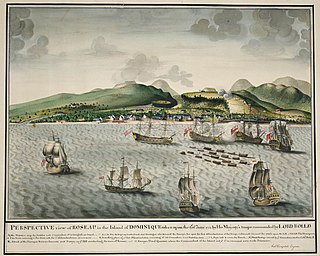HMS Norfolk was a 74-gun third-rate ship of the line of the Royal Navy, and the second ship to bear the name. She was built by Adrian Hayes at Deptford Dockyard and launched on 8 December 1757. She was active during the Seven Years' War.

The Bellona-class ships of the line were a class of five 74-gun third rates, whose design for the Royal Navy by Sir Thomas Slade was approved on 31 January 1758. Three ships were ordered on 28 December 1757, with names being assigned on 1 February 1758. Two further ships to this design were ordered on 13 December 1758, at the same time as two ships of a revised design – the Arrogant class.

The Dublin-class ships of the line were a class of seven 74-gun third rates, designed for the Royal Navy by Sir Thomas Slade.

HMS Dublin was a 74-gun third rate ship of the line of the Royal Navy, built by Adam Hayes at Deptford Dockyard and launched on 6 May 1757.

HMS Duke was a 90-gun second-rate ship of the line of the Royal Navy, launched on 13 June 1682 at Woolwich Dockyard.

HMS Prince was a 100-gun first rate ship of the line of the Royal Navy, built by Phineas Pett the Younger at Deptford Dockyard and launched in 1670.

HMS Royal Sovereign was a 100-gun first rate ship of the line of the Royal Navy, built at Woolwich Dockyard and launched in July 1701. She had been built using some of the salvageable timbers from the previous Royal Sovereign, which had been destroyed by fire in 1697.
Duc d'Aquitaine was a 64-gun East Indiaman of the Compagnie des Indes, launched in 1754. On 30 May 1757, she was captured by the Royal Navy and commissioned as the third rate HMS Duc D'Aquitaine. She foundered in 1761 and was lost.
HMS Dorsetshire, the first Royal Navy ship to be named after the county of Dorset, was an 80-gun third rate ship of the line of the Royal Navy, launched at Southampton on 8 December 1694.

HMS Ipswich was a 70-gun third-rate ship of the line of the Royal Navy, launched at Harwich on 19 April 1694.
HMS Romney was a 50-gun fourth rate ship of the line of the Royal Navy, built by Sir Joseph Allin to the 1706 Establishment at Deptford Dockyard, and launched on 2 December 1708.
HMS Sunderland was a 60-gun fourth rate ship of the line of the Royal Navy, built to the 1719 Establishment at Chatham Dockyard, and launched on 30 April 1724.

HMS Augusta was a 60-gun fourth-rate ship of the line of the Royal Navy, built to the 1733 proposals of the 1719 Establishment at Deptford Dockyard, and launched on 1 July 1736.

HMS Defiance was a 58-gun fourth rate ship of the line of the Royal Navy, built to the dimensions laid out in the 1741 proposals of the 1719 Establishment at Deptford, and launched on 12 October 1744.

HMS Harwich was a 50-gun fourth rate ship of the line of the Royal Navy, built at King's Yard in Harwich by John Barnard to the dimensions laid down in the 1741 proposals of the 1719 Establishment at Harwich, and launched on 22 December 1743.
HMS Chichester was a 70-gun third rate ship of the line of the Royal Navy, designed by Sir Joseph Allin and built by Peirson Lock at Portsmouth Dockyard to the standard draught for 70-gun ships as specified in the 1745 Establishment amended in 1750, and launched on 4 June 1753.
HMS Burford was a 70-gun third rate ship of the line of the Royal Navy, built at Chatham Dockyard to the draught specified by the 1745 Establishment as amended in 1754, and launched in 1757.

The Burford class were three 68-gun third-rate ships of the line designed for the Royal Navy by Sir Joseph Allin. The Burford ships were almost the last "70-gun" ships designed by Allin. They were built to the draught specified by the 1745 Establishment as amended in 1754.

HMS Achilles was a 60-gun fourth-rate ship of the line of the Royal Navy, built by Barnard and Turner at Harwich to the draught specified by the 1745 Establishment as amended in 1750, and launched in 1757. She was ordered in November 1755. HMS Achilles was a Dunkirk-class fourth rate, along with HMS Dunkirk and HMS America.

The action of 29 April 1758 was a naval engagement fought in the Bay of Biscay near Brest between a British Royal Navy squadron and a single French Navy ship of the line during the Seven Years' War. In an attempt to support the garrison of Louisbourg, who were facing an impending siege, the French Atlantic Fleet sent a number of squadrons and ships to sea during the spring of 1758. To intercept these ships, Royal Navy squadrons maintained a close blockade of their main port at Brest. In April a British squadron including HMS Intrepid, HMS Dorsetshire and HMS Achilles was cruising off the French Biscay Coast when a lone sail was sighted to the southwest. Dorsetshire, commanded by Captain Peter Denis was sent to investigate, discovering the ship to be the French ship of the line Raisonnable sailing to Louisbourg. In a fierce battle, Dorsetshire managed to inflict heavy casualties on the French ship and force her captain, Louis-Armand-Constantin de Rohan, to surrender.













